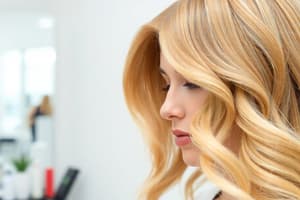Podcast
Questions and Answers
With resistant porosity, cuticles are?
With resistant porosity, cuticles are?
smooth
A nonoxidative process that uses large and small color molecules and allows small color molecules to penetrate the cuticle and enter the cortex is called?
A nonoxidative process that uses large and small color molecules and allows small color molecules to penetrate the cuticle and enter the cortex is called?
Semi-permanent coloring
The two types of melanin found in the cortex of the hair are eumelanin and?
The two types of melanin found in the cortex of the hair are eumelanin and?
PhenomeAnin
The tone of a hair color can be described as?
The tone of a hair color can be described as?
Permanent hair color is mixed with?
Permanent hair color is mixed with?
Which of the following items is an oxidizing agent used with Demi-permanent colors lighteners and toners?
Which of the following items is an oxidizing agent used with Demi-permanent colors lighteners and toners?
Why does the base area lighten faster when using a midstrand-to-ends then base technique?
Why does the base area lighten faster when using a midstrand-to-ends then base technique?
Which of the following types of products deposit color or lighten and deposit color in a single process technique?
Which of the following types of products deposit color or lighten and deposit color in a single process technique?
Dimensional coloring techniques that uses a darker color on selected strands is referred to as?
Dimensional coloring techniques that uses a darker color on selected strands is referred to as?
High lift tints are designed to achieve lighter colors and are generally mixed with a double amount of?
High lift tints are designed to achieve lighter colors and are generally mixed with a double amount of?
If a client has approximately 25 or 30 gray hairs, a color should be applied?
If a client has approximately 25 or 30 gray hairs, a color should be applied?
Hair color products that are mixed with a developer to create a chemical change are called?
Hair color products that are mixed with a developer to create a chemical change are called?
Flashcards are hidden until you start studying
Study Notes
Hair Color Fundamentals
- Cuticles with resistant porosity are described as smooth, affecting how color penetrates the hair.
- Semi-permanent coloring involves a nonoxidative process allowing small color molecules to enter the cortex through the cuticle.
- The two types of melanin in hair are eumelanin and pheomelanin, contributing to the hair's natural color characteristics.
- Hair color tones can be classified into three categories: warm, cool, or neutral.
Permanent and Demi-Permanent Coloring
- Permanent hair color requires mixing with hydrogen peroxide to facilitate the color change.
- An oxidizing agent used in demi-permanent colors, lighteners, and toners is crucial for achieving desired results.
- Hair lightening is enhanced by body heat, which causes the base area to lighten faster when using a midstrand-to-ends technique.
Color Application Techniques
- Oxidative products can both lighten and deposit color in a single process, streamlining application methods.
- Dimensional coloring techniques, such as low lighting, apply darker colors to selected strands for depth and contrast.
- High lift tints are specifically formulated to achieve lighter colors and are mixed with a concentration of 30 to 40 volume hydrogen peroxide.
Client Consultation and Color Selection
- Clients with around 25 to 30% gray hair should be advised to use a shade that is one level lighter than the desired result for optimal coverage.
- Oxidative color products create a chemical change when mixed with a developer, allowing for long-lasting color results.
Studying That Suits You
Use AI to generate personalized quizzes and flashcards to suit your learning preferences.





